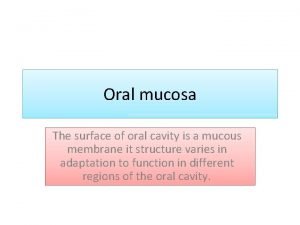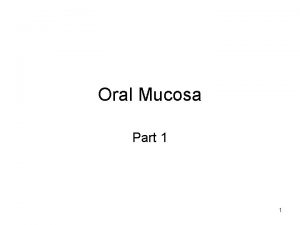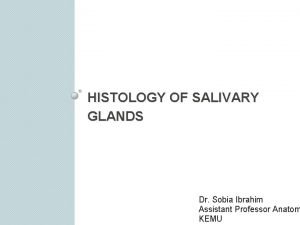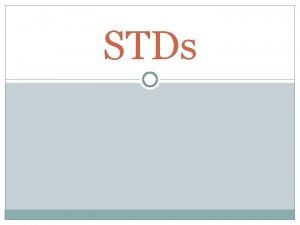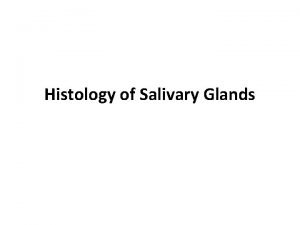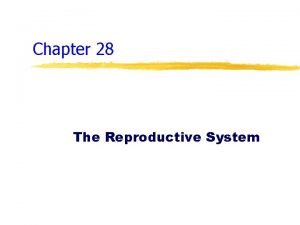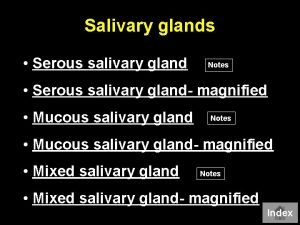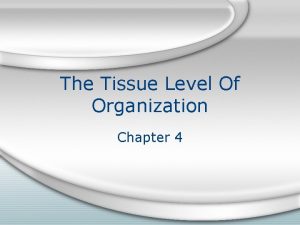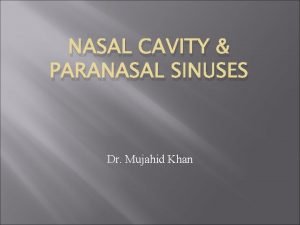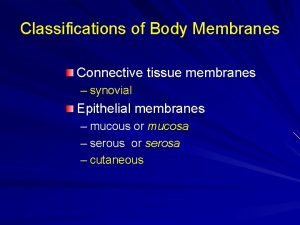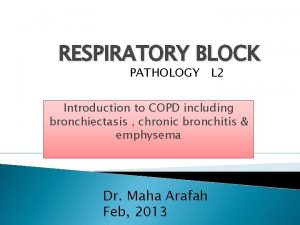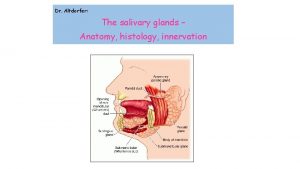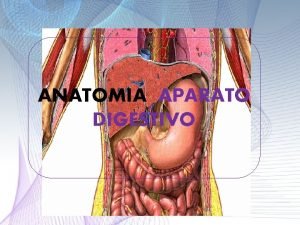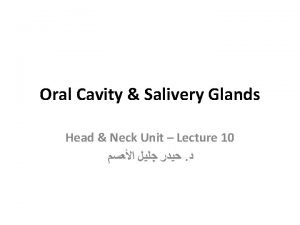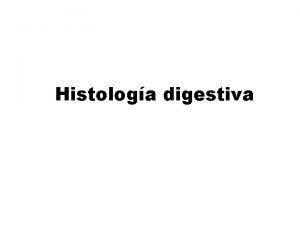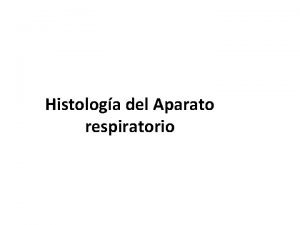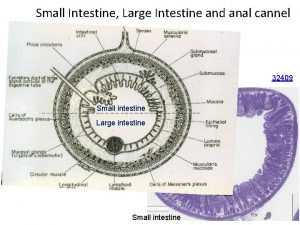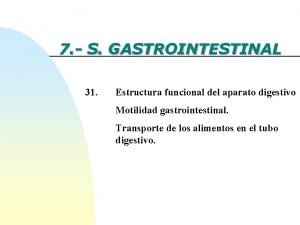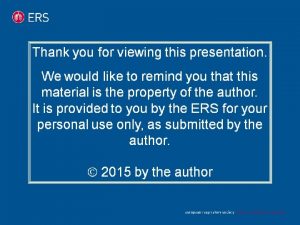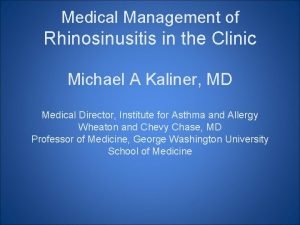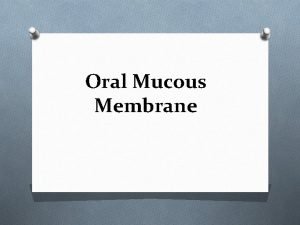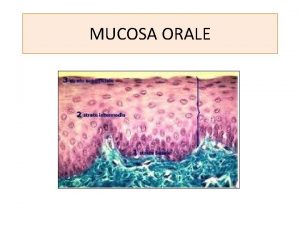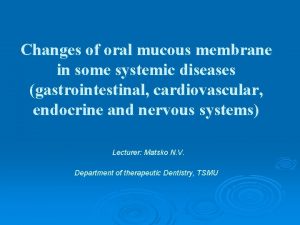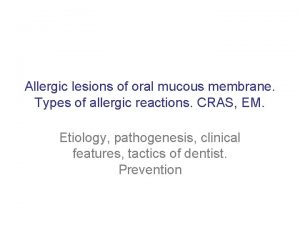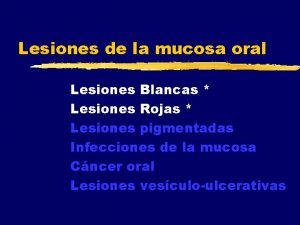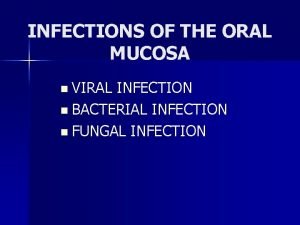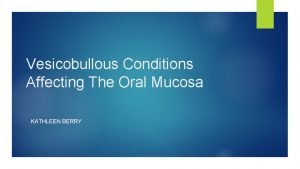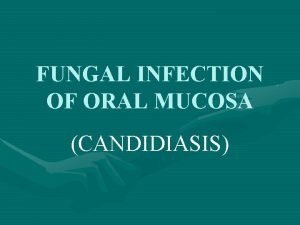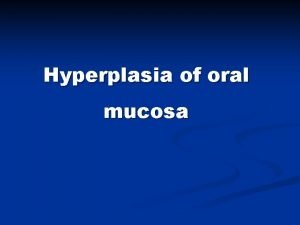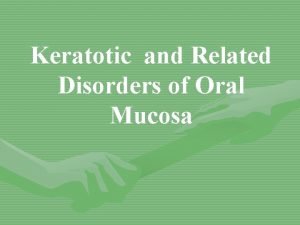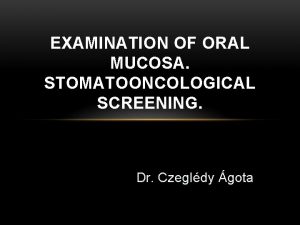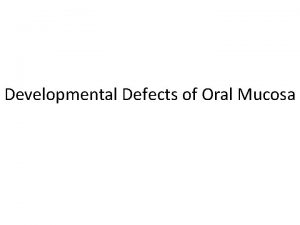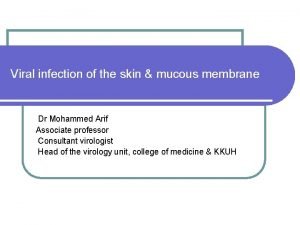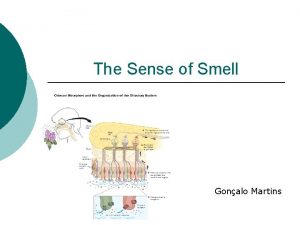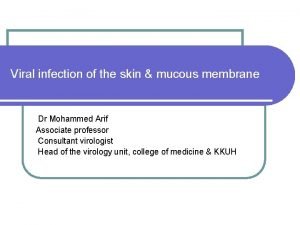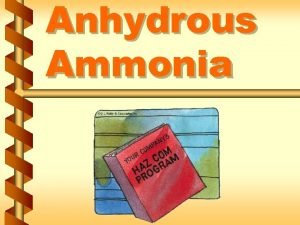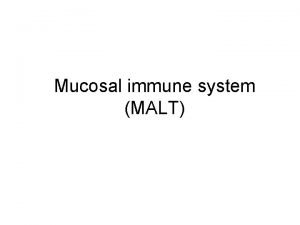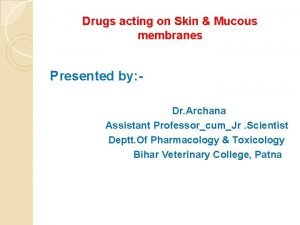Oral Mucosa Part 1 1 Oral Mucosa Mucous





























- Slides: 29

Oral Mucosa Part 1 1

Oral Mucosa Mucous Membrane: Moist lining of the gastrointestinal tract, nasal passages and other body cavities that communicate with the exterior In the oral cavity the lining is called as oral mucous membrane or oral mucosa The oral mucosa begins at the junction of the vermillion and labial mucosa Lips mark the entrance into the oral cavity External or “dry” area Vermillion between the external and internal Inner aspect of the lip 2

Oral Mucosa • Posterior aspect – Palatopharyngeal folds (opening of the oropharynx) – Palatoglossal folds 3

Functions of the Oral Mucosa 1. Protection: Barrier for mechanical trauma and microbiological insults 2. Sensation: Temperature (heat and cold), touch, pain, taste buds, thirst; reflexes such as swallowing, retching, gagging and salivating 3. Secretion: Salivary secretion 4. Thermal regulation: Important in dogs not in humans; panting dogs 4

Organization of the Oral Mucosa 3 types according to FUNCTION: 1. Masticatory Mucosa: 25% of total mucosa. Gingiva (free, attached and interdental) and hard palate. Primary mucosa to be in contact with food during mastication. MASTICATORY MUCOSA IS USUALLY KERATINIZED. 2. Lining Mucosa: 60% of total mucosa. Covers the floor of mouth, ventral (underside) tongue, alveolar mucosa, cheeks, lips and soft palate. Does not function in mastication and therefore has minimal attrition. Non-keratinized; soft and pliable. 3. Specialized Mucosa: 15% of total mucosa. Covers dorsal tongue and composed of cornified epithelial papillae. 5

Masticatory Mucosa 6

Masticatory Mucosa 7

Lining Mucosa 8

Specialized Mucosa 9

General Features of Oral Mucosa 1. Separated from the skin by vermillion zone of the lips which is more deeply colored than rest of the oral mucosa 2. Factors affecting color of the oral mucosa: a. Concentration and state of dilation of the blood vessels in underlying connective tissue b. Thickness of the epithelium c. Degree of keratinization d. Amount of melanin pigmentation Clinically, color of oral mucosa is very important. For example, inflamed oral tissues appear red rather than the normal pale pink 10

11

How is the oral mucosa different from skin? 1. Color 2. Moist surface 3. Absence of adnexal skin structures such as hair follicles, sweat glands and sebaceous glands (exception in Fordyce’s disease) Fordyce’s disease: Sebaceous glands in oral cavity predominantly in upper lip, buccal mucosa and alveolar mucosa 4. Presence of minor salivary glands in oral mucosa 5. Texture of surface: Oral mucosa is smoother than the skin (few exceptions like dorsal tongue – due to papillae; hard palate – rugae; gingiva – stippling) 6. Firmness: Oral mucosa varies in its firmness. For example buccal mucosa and lips are loose and pliable whereas the gingiva and hard palate are firm so critical clinically while giving injections 12

Skin Oral Mucosa-Cheek 13

Fordyce’s Spots • Pale yellow spots • Normal variation • Lips, buccal mucosa, alveolar mucosa and tonsillar pillar 14

Structure of Oral Mucosa 1. Overlying oral epithelium 2. Underlying connective tissue (lamina propria and submucosa) In skin called epidermis and dermis Rete ridges/pegs Connective tissue papilla 15

A: Epithelium B: Connective tissue C: Salivary gland A: Startum basale B: Startum spinosum C: Startum superficiale The oral epithelium is keratinized or non-keratinized stratified squamous epithelium The interface between epithelium and connective tissue is called basement membrane Downward projections of epithelium called rete ridges or rete pegs, and upward projection of connective tissue termed as connective tissue papillae http: //dentistry. ouhsc. edu/intranet-WEB/Courses/CELL 8002/Home. html 16

Junction between oral epithelium and lamina propria is more obvious than that between lamina propria and submucosa No muscularis mucosae layer seen in oral mucosa Loose fat and glandular tissue with blood vessels and nerves seen underneath oral mucosa from underneath bone or muscle layer - this layer is termed SUBMUCOSA – provides flexibility In gingiva and hard palate, no submucosa is seen and the lamina propria is directly attached to the periosteum of the underlying bone which provides firm, inelastic attachment – 17 this is called ORAL MUCOPERIOSTEUM

Connective tissue in oral cavity is comprised of salivary glands, sebaceous glands (Fordyce’s disease) and lymphoid tissue (tonsillar tissue) Salivary glands Sebaceous glands Lymphoid tissue (tonsil) High Power view of sebaceous glands www. usc. edu/hsc/dental/opfs/QL/09 tn. html http: //www. usc. edu/hsc/dental/ohisto/index. html http: //dentistry. ouhsc. edu/intranet-WEB/Courses/CELL 8002/Home. html 18

Oral Epithelium Progenitor population: Divide and provide new cells (Proliferation) Maturing population: Undergo differentiation (maturation) Estimated time necessary to replace all the cells in the epithelium: turnover time Skin: 52 to 75 days Gut: 4 to 14 days Gingiva: 41 to 57 days Cheek: 25 days Nonkeratinized epithelium turns over faster than keratininzed epithelium Clinical correlation: Oral ulcers during cancer chemotherapeutic treatment 19

Types of Oral Epithelium Orthokeratinized stratified Parakeratinized stratified squamous epithelium Nonkeratinized stratified squamous epithelium 20

Components of Oral Epithelium Lining Mucosa: Stratum Basale: Basal cell layer comprised of cuboidal cells. Progenitor cells that divide and provide new cells by mitotic division that migrate to the surface to replace cells that are shed. Stratum Spinosum (or intermedium): Cells are oval and represent bulk of the epithelium. Stratum Superficiale: Cells are flat and contain small oval nuclei that are continuously shed. 21

Histology of Lip Skin: keratinized stratified squamous epithelium with adnexal skin structures Oral Mucosa: Moist-surface, covered by nonkeratinized stratified squamous epithelium associated with small round seromucous glands of the lamina propria. In the submucosa fibers of orbicularis oris muscle is noted. Vermillion zone: Very thin keratinized epithelium that contains no adnexal skin structures (can contain sebaceous glands) A: Skin B: Vermillion zone C: Oral (labial) mucosa D: Minor salivary glands http: //dentistry. ouhsc. edu/intranet-WEB/Courses/CELL 8002/Home. html What gives the vermillion zone the red color? 1. Epithelium is thin 2. Epithelium contains eleidin, which is transparent 3. Blood vessels are present near the surface Eleidin is a semi-fluid clear substance present in the stratum lucidum of the skin epithelium 22

Skin of the Lip A: Sweat glands B: Sebaceous glands C: Hair follicles http: //dentistry. ouhsc. edu/intranet-WEB/Courses/CELL 8002/Home. html Vermillion Zone and Labial Mucosa A: Vermillion zone B: Labial mucosa C: Orbicularis oris muscle 23

Soft palate A: Hard Palate B; Soft palate C: Nasal cavity http: //dentistry. ouhsc. edu/intranet-WEB/Courses/CELL 8002/Home. html 1. Nonkeratinized 2. Highly vascularized so more pink than hard palate 2. Lamina propria and submucosa present (unlike hard palate when only lamina propria is noted – mucoperiosteum) 3. Submucosa contains salivary 24 glands and muscle soft palate

Cheeks (Buccal Mucosa) Similar to lips and soft palate Nonkeratinized stratified squamous epithelium, lamina propria and submucosa Submucosa of cheeks contain fat cells along with lobules of minor salivary glands and muscle fibers 25

Ventral surface of tongue Floor of mouth Nonkeratinized stratified squamous epithelium, lamina propria and submucosa Epithelium is loosely attached to lamina propria Extremely dense muscle fibers interlacing connective tissue fibers 26 No muscle in submucosa

Masticatory Mucosa Epithelium that covers gingiva and hard palate Mucosa is thicker than nonkeratinized because of the keratin layer Stratum basale Startum spinosum Same as nonkeratinized epithelium Stratum granulosum: Cells contain keratohyaline granules Stratum corneum: Contains thin, flat and nonnucleated cells which are filled with keratin. In contrast to the hard keratin seen in nails and hair, keratin overlying normal masticatory oral mucosa is soft. Keratin is tough, nonliving material that is resistant to friction and impervious to bacterial invasion 27 Miller SE. Histology for Pathologists. 3 rd edition. LWW. 2007

28

Types of Keratinized Epithelium Miller SE. Histology for Pathologists. 3 rd edition. LWW. 2007 The superficial cells are dead but retain the nucleus in parakeratinized epithelium but the nuclei are lost in orthokeratinized epithelium The rete pegs are long and slender in keratinized epithelium Mucoperiosteum http: //dentistry. ouhsc. edu/intranet-WEB/Courses/CELL 8002/Home. html 29
 Prickle cell layer oral mucosa
Prickle cell layer oral mucosa Epithelium types
Epithelium types Striated duct
Striated duct A bacterial std that usually affects mucous membranes
A bacterial std that usually affects mucous membranes Difference between serous and mucous acini
Difference between serous and mucous acini Animal tissue
Animal tissue Posterior view of the female reproductive organs
Posterior view of the female reproductive organs Merocrine glands vs apocrine glands
Merocrine glands vs apocrine glands Serous vs mucous glands
Serous vs mucous glands Chapter 25 sexually transmitted infections and hiv/aids
Chapter 25 sexually transmitted infections and hiv/aids Connective tissue cells
Connective tissue cells Mucous connective tissue
Mucous connective tissue Paranasal sinuses
Paranasal sinuses Serous mucous synovial and cutaneous membranes
Serous mucous synovial and cutaneous membranes Fundus of stomach histology
Fundus of stomach histology Classification of emphysema
Classification of emphysema Weber gland
Weber gland Intestino grueso
Intestino grueso Valvola mucosa di von gubaroff
Valvola mucosa di von gubaroff Respiratory mucosa
Respiratory mucosa Squamoglandular mucosa
Squamoglandular mucosa Floor of mouth anatomy
Floor of mouth anatomy Histolyguide
Histolyguide Histologia bronquiolos
Histologia bronquiolos Lymphoid nodule colon
Lymphoid nodule colon Plicae circularis
Plicae circularis Secrecion mucosa
Secrecion mucosa Albert osterhaus
Albert osterhaus Procendentia
Procendentia Nasal mucosa inflammation
Nasal mucosa inflammation
